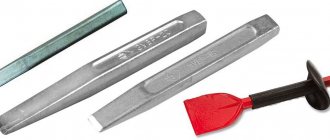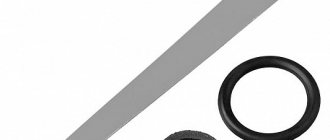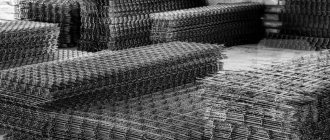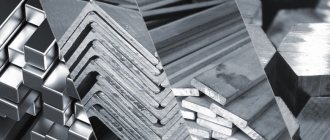Metal sheets are the most popular rolled metal products. Construction, repairs and other areas of human activity cannot do without flat rolled steel, which is used in different ways. Products made from metal sheets surround us everywhere in everyday life: car body, roofing, building facades, ventilation systems, art products, steel pipes - all this is made from sheet steel. Therefore, you can buy sheet steel as a blank for the further manufacture of all kinds of goods or as a finished building material.
Metal sheets are selected for specific tasks based on their thickness, type of steel used and other features. They are flat, rectangular-shaped products that, due to their flexibility and ductility, can be processed into specific shapes. In many cases, special treatments are added to the composition or carried out in order to preserve and protect the metal product from external atmospheric and climatic influences, increase its resistance to impacts or improve surface properties.
Sheet steel is classified according to sheet thickness as thin sheet (from 0.35 to 3.9 mm) and thick sheet (from 4 to 160 mm).
Sheet steel by rolling type
Based on the type of rolling, products are classified into cold-rolled and hot-rolled. They can then be subjected to treatments such as heat treatment and skin tempering to increase their yield strength or zinc coating to protect against corrosion.
Cold rolled steel
The manufacturing process involves placing a metal alloy between rollers located at the top and bottom. They deform the metal into a thinner piece or sheet than its original size.
The blank for cold-rolled products is hot-rolled. Its properties are improved: the metal is washed with acid at the manufacturing plant before the final rolling is completed. The final stage of obtaining the material consists of heat treatment, known as annealing. Cold rolled steel is harder and stronger than hot rolled steel and looks more presentable. Cold rolled steel sheets and coils are commonly used where dimensional tolerances, strength and surface finish are critical.
Areas of application of cold-rolled sheet metal products: ♦ Metal furniture. ♦ Automotive components. ♦ Electronic equipment. ♦ Household appliances and components. ♦ Lighting lamps. ♦ Construction of buildings.
Hot rolled steel
Products of this type are subjected to rolling processes at temperatures above 750 degrees Celsius. Due to their unsightly appearance, they are usually used where finishing is not critical to the project. This is one of the types of steel most often used for the manufacture of parts of mechanically welded structures, for bending or profiling, assembly by welding, and even for artistic sculptures. The color variations on the steel sheets give character to the entire sculpture.
Description and types of sheet steel
Sheet steel is a type of rolled metal product, which is a sheet of metal used for the manufacture of various metal structures (profiles, hulls for ships, bodies for trucks, as well as various household appliances). Thus, the scope of application of this product is very wide. Also, its use contributes to optimization and profitable reduction of costs for the production of various products.
The following types of sheet metal are distinguished:
- hot- and cold-rolled (varies by the method of its production);
- thin- and thick-sheet (depending on the thickness of the sheet; the first option includes a thickness of up to 4 mm, the second – from 4 mm).
- rolled and sheet (depending on the type in which it is delivered to the buyer).
Rolled products with thin sheets are produced in the range from 0.5 mm to 4 mm. There are hot-rolled sheets with a cut edge and rolled sheets with a cut and uncut edge. It is manufactured in accordance with all GOST standards.
Rolled products with thick sheets are produced in the range from 4 mm to 160 mm and come in sheet and roll forms.
Metal sheets are also divided depending on the quality of their processing: with extra high, high and enhanced finishing.
Depending on the ability of rolled products to draw, rolled products with deep and normal drawing levels are distinguished. Also, according to this criterion, steel with a very particularly complex, particularly complex, complex and very deep degree of drawing is distinguished.
Sheet steel by processing method
Galvanized sheets
Galvanized steel has a zinc coating, so it is a more durable material that is resistant to atmospheric and aggressive influences. It is widely used in construction and component manufacturing due to its characteristics of durability and stability over a long service life.
Galvanized sheets are used: ♦ In construction. ♦ Mechanical engineering, automotive industry. ♦ In the manufacture of pipes. ♦ For the production of roofing materials. ♦ In the chemical and food industries. ♦ For external decoration of balconies, walls, fences.
Sheet metal: types, characteristics and purpose
The main qualitative characteristics of sheet metal are the following indicators:
- Manufacturing technology. All types of stainless steel sheets are created by hot or cold deformation. At the same time, hot-rolled options are more in demand due to their excellent set of physical and mechanical properties.
- Dimensions. Sheets may have different thicknesses, widths or heights; the standard values are specified in GOST, but each manufacturer can introduce a new product category with its own dimensions.
- Rolling accuracy, edge trimming and flatness. These characteristics also depend on the brand of the product, and manufacturers offer several sheet metal options for these values.
Separate points are the grade of steel used and the presence of additional processing. The main products of rolled sheets are the following types of metal sheets:
- Smooth. Sheet metal with a painted surface can have different thicknesses and overall dimensions, and its distinctive advantage is its attractive appearance. The main area of use is finishing work.
- Smooth galvanized. After forming, the metal undergoes an additional stage of processing with a zinc compound to improve performance characteristics. The alloy becomes resistant to corrosion, withstands temperature changes and has a long service life. The scope of use of such a product is much wider, and different types of galvanized sheets make it possible to select raw materials for any production needs.
- Perforated. The metal sheet is processed on a special machine, and a through pattern of holes appears on its surface. Depending on the purpose, the diameter and location of the holes may vary, but the main area of use of such a product does not extend beyond finishing work.
- Stainless. One of the most popular rolled metal products, which is used both for finishing and for the production of various parts. The distinctive quality of the material lies in its heat resistance and corrosion resistance, so the finished structure can last a long time and retain its strength in any environmental conditions.
- Profiled. Decorative sheets with a corrugated surface are widely used for finishing various structures and can be used for wall or roof cladding.
Advantages and disadvantages
When choosing a specific type of sheet metal, you need to take into account a set of mandatory performance characteristics. Depending on the manufacturing technology and sheet thickness, the physical and mechanical properties of the metal can differ significantly from each other. For example, cold-rolled types of profiled sheets are made with a thickness of no more than 4 mm, so you cannot count on a high strength index.
The main advantages of using such material of any kind are the following qualities:
- Manufacturability. The metal sheet lends itself well to forming, stamping or welding. The correct geometric shape makes it possible to make accurate calculations for material consumption or work with structures of complex shapes.
- Wear resistance. All types of galvanized sheets are in high demand in areas where aggressive components and chemical compounds are used. However, corrosion resistance, thermal conductivity or strength depend entirely on the grade of steel used.
- Diversity. Sheets can have a cut edge, a painted surface and different thicknesses, so it is possible to choose a material for any application.
We should talk about the disadvantages of sheet metal only from the point of view of the suitability of the material used for its intended purpose. For example, all types of perforated sheets are resistant to atmospheric factors, corrosion and mechanical stress. However, the presence of holes excludes the insulating property, and such metal can only be used as a finishing material.
Area of use
A wide range of performance characteristics is the main advantage of this material. Sheet metal is used for industrial purposes and acts as the main raw material in the manufacture of various equipment. The same type of rolled metal can be used for construction purposes and for finishing the premises. High-quality metal in sheet format is indispensable in the following industries:
- mechanical and instrument engineering;
- shipbuilding and aviation;
- construction;
- Agriculture;
- wide range production.
Some types of profile sheets are used for cladding roofs and facades; corrugated sheets are used for finishing steps and for decorating the interior.
If you are planning construction of any category, then you will definitely need high-quality metal sheets. You can choose an option to suit your requirements at UTK-Steel. The company's consultants will help you choose a product for the designated task.
Where else is sheet steel used?
Sheet metal has many different uses in interior and exterior design. It is capable of soundproofing and optimizing air, so it is excellent for ceilings and also for dividing spaces. In addition, elements such as tables, shelves, partitions, railings, drawers, containers, etc. are made from sheet steel. The small thickness of the product makes it possible to bend it, creating a variety of bent or profile products.
Thick sheets are used to create metal frames, in the construction of welded structures, and in the manufacture of various parts.
Rolled sheets - what they are and what they are used for
In industry and construction, products such as rolled sheets are often used, which are metal sheets made in the shape of a rectangle. They can have different lengths, widths and thicknesses. This product also includes steel coils. Unlike long products, this product is usually created using cold rolling, so it has a more uniform thickness and a high surface finish.
On sale you can find metal sheets coated with zinc and other protective agents. By the way, you can purchase them in St. Petersburg here, at JSC Steel Industry Company, which has been selling high-quality rolled metal from large manufacturers for several years now.
Features of the manufacture and use of sheet metal
These products are most often used to create various parts and objects from them, such as vehicle bodies, containers, equipment, metal structures, and so on, by cutting and stamping them. Corrugated metal sheets can be good building materials used for laying high-quality roofing or developing special-purpose parts.
Steel sheets are created using high-quality steel with low to medium carbon content. Materials of different grades may be suitable, including St 0, 1, 2 and so on. They are also made from alloy steel. It is for this reason that the production of these products has been put into production.
Main characteristics of galvanized sheet
Galvanized sheets are produced by applying a zinc layer to cold-rolled coils or sheets, which protects the base metal from corrosive destruction. The most common methods of galvanizing in industrial conditions are hot and electrolytic. The main application of such a sheet is the production of corrugated sheets. It is also used for the manufacture of technological equipment, household appliances, and in the furniture industry.
| Sheet thickness, mm | Weight 1 m 2, kg | Sheet thickness, mm | Weight 1 m 2, kg |
| 0,45 | 3,73 | 1,2 | 9,62 |
| 0,5 | 4,13 | 1,5 | 11,98 |
| 0,55 | 4,52 | 2,0 | 15,9 |
| 0,7 | 5,7 | 2,5 | 19,83 |
| 0,8 | 6,48 | 3,0 | 23,75 |
| 1,0 | 8,05 |
Range of cold rolled steel sheets
The production of these metal products is regulated by GOSTs 19904-90, 9045-93, 16523-97. Thickness – up to 5.0 mm. Width – 500-2350 mm. Manufacturing accuracy in thickness - high, increased, normal. Flatness – especially high, high, improved, normal. General-purpose products are made from high-quality carbon steels, and for certain applications - from low-alloy or alloy steels. Such products are characterized by high dimensional accuracy and surface quality, as well as a hardened top layer. To eliminate work hardening and obtain a fine-grained structure in the surface layer, recrystallization annealing is used.
Cold-rolled sheets are used in the production of profiled sheets, in the automotive industry, in the manufacture of dishes coated with enamel, and containers for canned food products.
Table of dimensions and weight of cold rolled steel sheets
| Sheet thickness, mm | Sheet dimensions, m x m | Weight 1 m 2, kg | Sheet weight, kg |
| 0,7 | 1.25x2.5 | 5,5 | 17,17 |
| 0,8 | 1.25x2.5 | 6,28 | 19,63 |
| 1,0 | 1.25x2.5 | 7,85 | 24,53 |
| 1,2 | 1.25x2.5 | 9,42 | 29,44 |
| 1,5 | 1.25x2.5 | 11,78 | 36,8 |
| 2,0 | 1.25x2.5 | 15,7 | 49,06 |
| 2,5 | 1.25x2.5 | 19,63 | 61,33 |
| 3,0 | 1.25x2.5 | 23,55 | 73,59 |
Galvanized corrugated sheeting: characteristics and areas of application
Profiled sheet is a metal product obtained by profiling cold-rolled galvanized sheets with a thickness of 0.4-1.0 mm on special bending mills. Various grades of this material are used for wall coverings, fencing, and roofing.
Table of sizes and weights of profiled sheets of various brands
| Brand | Thickness, mm | Width, mm | Weight of 1 linear meter, kg |
| C8 | 0,5 | 1150 | 5,4 |
| C8 | 0,55 | 1150 | 5,9 |
| C8 | 0,6 | 1150 | 6,3 |
| C8 | 0,7 | 1150 | 7,4 |
| S21 | 0,55 | 1000 | 5,4 |
| S21 | 0,7 | 1000 | 5,9 |
| S21 | 0,8 | 1000 | 6,3 |
| S21 | 0,9 | 1000 | 7,4 |
| NS35 | 0,5 | 1000 | 5,4 |
| NS35 | 0,55 | 1000 | 5,9 |
| NS35 | 0,7 | 1000 | 6,3 |
| NS35 | 0,8 | 1000 | 7,4 |
| H57 | 0,6 | 750 | 5,6 |
| H57 | 0,7 | 750 | 6,5 |
| H57 | 0,8 | 750 | 7,49 |
| H75 | 0,6 | 750 | 6,3 |
| H75 | 0,7 | 750 | 7,4 |
| H75 | 0,8 | 750 | 8,4 |
| H75 | 0,9 | 750 | 9,3 |
| H75 | 1,0 | 750 | 10,3 |
| H114 | 0,7 | 600 | 7,35 |
| H114 | 0,8 | 600 | 8,4 |
| H114 | 0,9 | 600 | 9,3 |
| H114 | 1,0 | 600 | 10,3 |
| H114 | 0,8 | 750 | 10,5 |
| H114 | 0,9 | 750 | 11,62 |
| H114 | 1,0 | 750 | 12,88 |
Application
Hot-rolled sheet steel is characterized by sufficient strength and low prices, but the matte surface with traces of scale does not look aesthetically pleasing. The most in demand is hot-rolled thick sheets. It is used for the manufacture of:
- cold-rolled sheet metal;
- bent profiles;
- containers, bunkers, cisterns;
- hulls of ships, trams, cars;
- building structures;
- various parts by stamping.
Cold-rolled sheet is stronger than hot-rolled sheet, has a smooth surface without flaws, but is more expensive. Area of application: production of corrugated sheets, metal tiles, stamped parts, car bodies, instruments, household appliances. Corrugated sheets are used for constructing floor coverings, stair steps and platforms in production workshops.
Types of sheet metal
There are several classifications of these materials. For example, according to their purpose, they can be divided into sheet metal for general and special use. The last group usually includes electrical steel sheets used in a variety of electrical mechanisms directly in magnetic circuits. They may also be suitable for creating individual elements of generators operating at higher frequencies.
These products are also divided by type of rolling: cold-rolled and hot-rolled, but as we have already noted above, the first option is the most popular. Based on the type of coating, sheet steel is divided into tinned, cadmium and galvanized. Plus, these metal sheets can be thin-sheet (sheet thickness is less than four millimeters) and thick-sheet (thickness varies from four to sixty millimeters).









